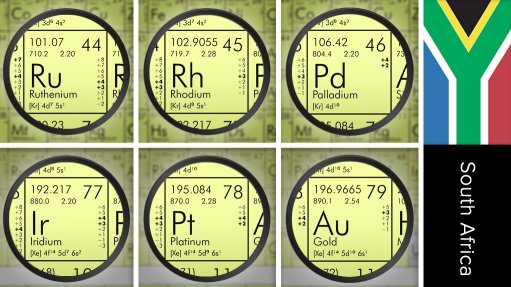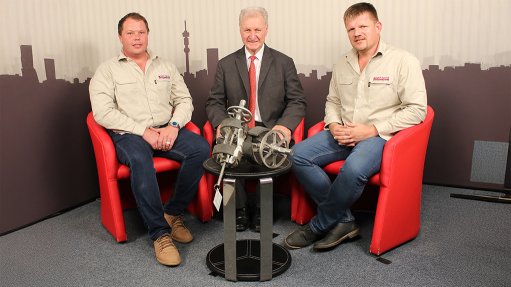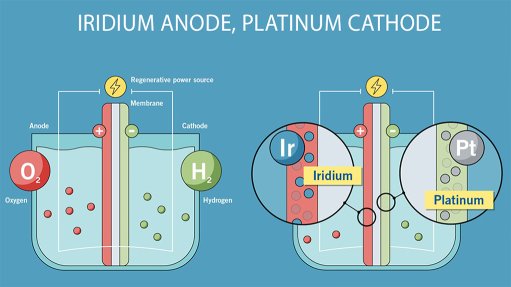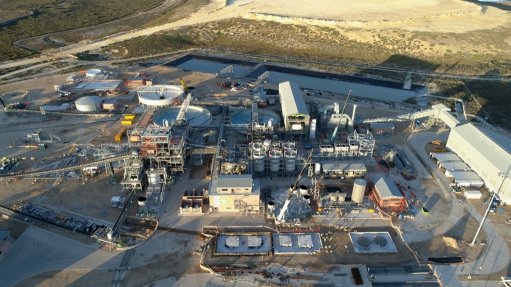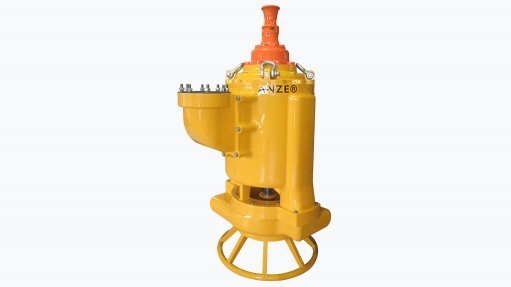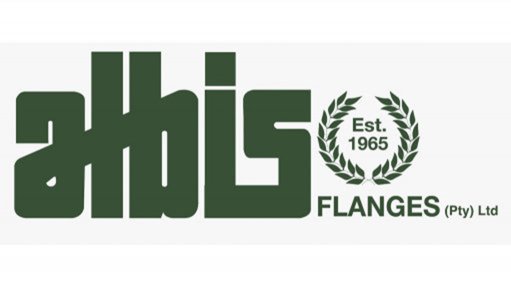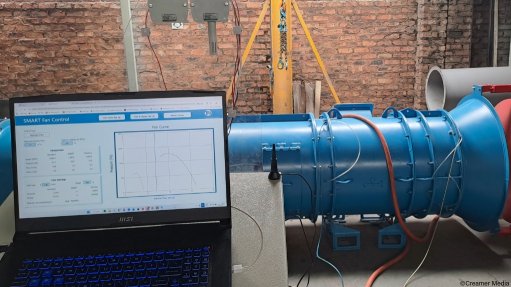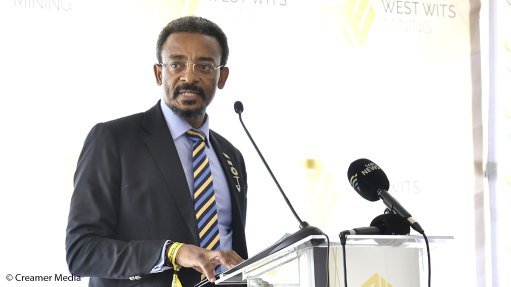Balanced 2026 platinum market forecast dependent on trade tension let-up

World Platinum's Edward Sterck interviewed by Mining Weekly's Martin Creamer. Video: Darlene Creamer.
JOHANNESBURG (miningweekly.com) – The platinum market is expected to move to being in balance in 2026 – but this is contingent on a lessening of the trade tensions that have accentuated this year’s substantial platinum market deficit of close to 700 000 oz.
Also to be noted is that a balanced market does not rebuild above ground stocks, which makes it very difficult to envisage a fundamental loosening of the tight market conditions that are likely to persist in 2026.
Meanwhile, on the way for 2025 is the third big consecutive annual deficit of 692 000 oz, which is a downward adjustment of 158 000 oz from the previous forecast thanks mainly to higher mining and recycling supply but with total 2025 supply still projected to be a five-year-low 7 129 000 oz and mining supply falling to a 5%-lower 5 510 000 oz, also its lowest level in five years.
On the demand side, total 2025 uptake of 7 821 000 oz is forecast, which is a 422 000 oz reduction on 2024, largely owing to the absence of expansions in the glass business.
On the 2026 supply side, a 4%-higher 7 404 000 oz is forecast owing to more recycling and 2%-higher mining production to 5 622 000 oz, while total demand is expected to contract by 6% (-436 000 oz) year-on-year to 7 385 000 oz. This fall is driven chiefly by an aggregated 540 000 oz swing in non-bar and coin investment demand, as warehouse stocks are drawn down from elevated levels on easing tariff-related uncertainty, with some profit taking by exchange traded fund (ETF) investors.
The World Platinum Investment Council (WPIC) has put forward a following year outlook in a current year Platinum Quarterly against the backdrop of trade tension-linked investment flows having accentuated the 2025 platinum market deficit in a big way.
“We’ve put forward our 2026 expectation of a broadly balanced market, going from a deficit this year of almost 700 000 oz to a 20 000 oz surplus, which is basically a balanced market for next year,” WPIC research director Edward Sterck told Mining Weekly in a Zoom interview following WPIC’s release of its Platinum Quarterly on platinum supply and demand movements for the third quarter of 2025, an updated forecast for 2025 and a first outlook for 2026.
While the expectation of a balanced market may be a bit of a surprise to many, it is heavily contingent upon an easing of trade tensions as well as ETF profit taking.
“In aggregate, those two segments contribute about 300 000 oz in change to the overall balance. Remove them, and we have a 300 000 oz deficit for next year, so the forecast of a balanced market is very contingent upon some fundamental changes in the way the world is operating right now.
“Trade tensions have persisted throughout the majority of this year. They've allowed the US to build up a significant strategic stockpile of critical minerals without the government having to fund anything. It's all been funded privately. This isn't just platinum, it's other metals as well.
“Then, in terms of ETF holdings, at one point we were up more than $700/oz in price terms, yet we still didn't see anyone selling their holdings on a net basis, so it’s contingent upon things changing in that regard next year.
“Why did the price move this year? Well, one possible reason, and there are a few others we could discuss as well, is that above ground stocks fell to unsustainably low levels, approximately from May of this year.
“A balanced market doesn't solve that. Above ground stocks would need to be replenished for us to see the tightness come out of the market, and that would require a substantial surplus in 2026,” Sterck explained.
Ongoing trade tensions would turn 2026 into another year of supply falling short of demand.
Platinum tightness remains, which is reflected by extremely high lease rates and deep backwardation in the London over-the-counter (OTC) forward market – a tightness which has remained during 2025’s substantial price uplift.
Rather than ETF liquidations reducing market tightness this year, ETF balances, despite the price increase, were net positive by the end of October. Tightness and 2026 price rises may well further incentivise ETF holders to up rather than lower their holdings.
Mining Weekly: What are the key factors attributing to the platinum market deficit forecast at the end of 2025?
Sterck: The main thing really is a very constrained supply environment. Mine supply is down 5% year on year. We do have a modest increase in recycling supply, but perhaps not as much as one would have expected given the price improvements we've seen since May of this year. If you look at the demand landscape, automotive demand is still relatively robust. Jewellery demand not up, perhaps, as much as we'd have expected it to be up back in the second quarter. Industrial demand is down, and that's mainly due to a cyclical downturn in terms of glass capacity additions, so, overall, it's really supply that is the limiting factor and that is something which I think could improve a little bit looking forward, depending upon what happens with prices. But overall, we're not expecting any staggering changes in the future.
What areas of demand growth do you see in 2026?
In automotive demand, we have a modest decline next year, and we do have a modest year-on-year decline next year for jewellery demand, but that's mainly because this year's jewellery demand figure was boosted by those second-quarter wholesale fabrication demands in China. If you look at jewellery versus 2024, actually we've got some reasonable growth. Then, in terms of industrial demand, we're expecting a return to some glass capacity additions in 2026 and so that creates modest growth for the overall industrial demand complex. In terms of investment demand, we're expecting continued growth in bar and coin demand, but the overall figure for investment demand is dragged down by those ETF profit taking numbers and the exchange stock outflows.
How do you see mine supply and recycling responding to higher prices?
We've got modest mining supply growth coming through next year. In part, that reflects that this year was slightly held back by the flooding in the first-quarter, although we do expect some normalisation of that in the fourth quarter of this year. But in terms of recycling supply, that's where we do see some growth coming through, and that's largely linked to an improved availability of end-of-life vehicles, and also higher prices supporting the economics of the recyclers.
Do higher prices pose a threat to demand?
So far, we've seen that they haven't. Demand has actually remained broadly at the levels that we would have expected at a lower price point. I think demand is, for the most part, pretty price inelastic. The areas where you can see some price elasticity are possibly jewellery and investment demand. But we've got to bear in mind that we're looking at this through the lens of the entire precious metals complex, and gold is still at extremely elevated levels. If gold is remaining high, then platinum, in terms of jewellery, is your, at the moment, lower cost alternative, and particularly with it when it comes to white gold, for example, where white gold has been trading at the retail level at a premium to platinum. Let's remember that white gold was actually produced as an alloy, as a low cost platinum alternative. Then, in terms of investment demand, again, gold is extremely expensive. There's strong competition from a number of different investors, including central banks. Platinum is relatively lower cost, and I think most consumers would look at the relative price outlook for platinum versus gold, and given that platinum used to trade at two times the price of gold, they might make some conclusions upon that. We're certainly seeing strong demand for platinum bars and coins, so I think for the most part, we'll probably see ongoing strength and demand for platinum, even at higher prices.
Coin and bar demand is set to grow by 30% in 2026, which countries are leading the way and why the increase in interest to a six-year high?
It's very much China led. We've seen a significant sea change in terms of the bar and coin investment landscape over the last five years or so, where the US used to be the most important market. China's a zero VAT market for platinum, unlike many other parts of the world. There's actually quite strong demand in the US for bar and coin. The problem is there isn't product availability. High lease rates have limited the capacity for the fabricators to produce platinum bar and coin for the US market and so what we're seeing is quite significant strength in demand in the secondary market there, so product that's been sold back and is being resold again. The area where we're seeing that really strong new demand growth is China, and I think that's very much linked to the fact that we're seeing these continued high gold prices.
What do the VAT changes in China mean for platinum demand?
We've seen a fairly widespread adjustment to the VAT environment for precious metals in China. It's affected platinum, but it's also affected gold. Now, the rules are a bit different between the two of them. For platinum, anything that's traded OTC or is imported directly, was and will continue to be subject to a 13% VAT charge. But previously, you used to be able to buy platinum through the Shanghai Gold Exchange, which was where you were given a VAT exempt certificate, but you were charged a 3% processing fee by an organisation called China Platinum Corporation. Effectively, there was a 10% benefit to buying platinum through the Shanghai Gold Exchange, and to a degree that slightly suppressed the secondary market there. What we've seen is that the authorities have removed that VAT exemption for the Shanghai Gold Exchange, and now you've got a level playing field between the Shanghai Gold Exchange and the OTC and direct import markets. And so we've seen Shanghai Gold Exchange volumes fall away, and then an increase in volumes in the secondary and direct import markets. One has to bear in mind that there’s going to be a bit of a price sensitivity factor to this, so we’ll probably see a bit of a drop off in volumes initially. Leading up to this, we saw significant increase in import volumes, and afterwards, a little bit of a drop off, but then we'd expect a normalisation of those volumes. Fundamentally, the market still needs the same amount of platinum, and so therefore you'll just see those purchases occurring in different places. In gold, on the other hand, what's happened is slightly more complex, but effectively, a lot of the gold VAT exemptions have been changed, so the benefit of buying gold through certain platforms has been reduced. The overall cost of buying gold has gone up, and those costs ultimately have to be passed on to the consumer. We see quite high price sensitivity in terms of more expensive gold jewellery purchases, for example, and more expensive gold jewellery, as we've seen so far this year, tends to benefit platinum, as currently the lower cost alternative to gold.
What is the investment case for platinum going forward and will we continue to see high prices?
Addressing the last point first, we don't forecast prices, but at this point in time, we've got very high lease rates. We've still got strong OTC backwardation, and those two things point to a shortage of metal in the spot market. The key thing here is that, in terms of the investment case, we've still got ongoing robust demand. We still have constrained supply. We’re expecting a modest improvement in that next year, but nothing transformative. Even though, on our base case forecasts, we have a balanced market next year, contingent upon those ETF profit taking volumes and an easing of trade tensions, allowing for exchange stock outflows, a balanced market doesn't solve for the shortages we've seen over the last few years. It doesn't rebuild above ground stocks and so kind of coming back to that market tension, it's very difficult for us, on these current forecasts, to envisage something that's going to fundamentally improve that situation, so we expect the tight market conditions to persist into next year.
PHYSICAL PLATINUM INVESTMENT
WPIC is a global market authority on physical platinum investment, formed to meet the growing investor demand for objective and reliable platinum market intelligence.
The council’s mission is to stimulate global investor demand for physical platinum through both actionable insights and targeted product development.
It was created in 2014 by South African platinum producers with its members made up of Valterra Platinum, Implats, Northam Platinum, Sedibelo Platinum, Tharisa, Bravo Mining and Podium Minerals.
Platinum is a metal with very distinctive qualities that give rise to diverse demand segments. Platinum’s catalytic properties are taken up in industrial applications and its precious metal attributes in jewellery.
Recycled supply is from end-of-life autocatalysts that keep vehicle exhaust fumes out of the atmosphere and from jewellery disposal.
In the last five years, between 72% and 79% of total annual refined platinum supply has been from mines.
Platinum demand from autocatalysts has equated to between 29% and 42% of total demand in the last five years, while its diverse non-automotive industrial uses account on average for 32% of total global demand on a five-year average.
Over the same period, global annual jewellery demand has averaged 26% of total platinum demand. Investment demand is the most variable category over the past five years, ranging between -8% and 21% of total demand, excluding movements in unpublished vaulted investor holdings.
Forecast 2025 automotive demand is 10% above prior five-year average, and jewellery demand growth 7% to 2 157 000 oz in 2025 uplifted by an upsurge in China in the first half of this year.
Total bar and coin investment is poised to record 47% year-on-year growth in 2025 led by strong demand in China.
Article Enquiry
Email Article
Save Article
Feedback
To advertise email advertising@creamermedia.co.za or click here
Announcements
What's On
Subscribe to improve your user experience...
Option 1 (equivalent of R125 a month):
Receive a weekly copy of Creamer Media's Engineering News & Mining Weekly magazine
(print copy for those in South Africa and e-magazine for those outside of South Africa)
Receive daily email newsletters
Access to full search results
Access archive of magazine back copies
Access to Projects in Progress
Access to ONE Research Report of your choice in PDF format
Option 2 (equivalent of R375 a month):
All benefits from Option 1
PLUS
Access to Creamer Media's Research Channel Africa for ALL Research Reports, in PDF format, on various industrial and mining sectors
including Electricity; Water; Energy Transition; Hydrogen; Roads, Rail and Ports; Coal; Gold; Platinum; Battery Metals; etc.
Already a subscriber?
Forgotten your password?
Receive weekly copy of Creamer Media's Engineering News & Mining Weekly magazine (print copy for those in South Africa and e-magazine for those outside of South Africa)
➕
Recieve daily email newsletters
➕
Access to full search results
➕
Access archive of magazine back copies
➕
Access to Projects in Progress
➕
Access to ONE Research Report of your choice in PDF format
RESEARCH CHANNEL AFRICA
R4500 (equivalent of R375 a month)
SUBSCRIBEAll benefits from Option 1
➕
Access to Creamer Media's Research Channel Africa for ALL Research Reports on various industrial and mining sectors, in PDF format, including on:
Electricity
➕
Water
➕
Energy Transition
➕
Hydrogen
➕
Roads, Rail and Ports
➕
Coal
➕
Gold
➕
Platinum
➕
Battery Metals
➕
etc.
Receive all benefits from Option 1 or Option 2 delivered to numerous people at your company
➕
Multiple User names and Passwords for simultaneous log-ins
➕
Intranet integration access to all in your organisation







